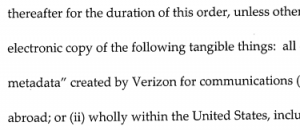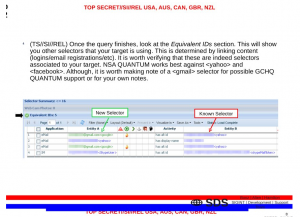Spy vs. Spy, Theresa Shea vs. Theresa Shea
The government has submitted its response to ACLU’s appeal of its lawsuit challenging the Section 215 dragnet.
This passage, which reminded me of the old Mad Magazine Spy vs. Spy comic, made me pee my pants in laughter.
Various details of the program remain classified, precluding further explanation here of its scope, but the absence of those details cannot justify unsupported assumptions. For example, the record does not support the conclusion that the program collects “virtually all telephony metadata” about telephone calls made or received in the United States. SPA 32, quoted in Pl. Br. 12; see also, e.g., Pl. Br. 1-2, 23, 24, 25, 48, 58. Nor is that conclusion correct. See Supp. Decl. of Teresa H. Shea ¶ 7, First Unitarian Church of Los Angeles v. NSA, No. 4:13cv3287 (filed Feb. 21, 2014).3
3 The precise scope of the program is immaterial, however, because, as we explain, the government should prevail as a matter of law even if the scope of the program were as plaintiffs describe. [my emphasis]
Note that they’re citing a declaration from SIGINT Director Theresa Shea submitted in another case, the EFF challenge to the phone dragnet? They’re citing that Shea declaration rather than the one Shea submitted in this very case.
In her declaration submitted in this case in October, Shea said NSA collected all the call records from the providers subject to Section 215.
Pursuant to Section 215, the FBI obtains from the FISC directing certain telecommunications service providers to produce all business records created by them (known as call detail records) that contain information about communications between telephone numbers, generally relating to telephone calls made between the U.S. and a foreign country and calls made entirely within the U.S. (¶14) [my emphasis]
Not all providers. But for the providers in question, “all business records.”
Remember, ACLU is suing on their own behalf, and they are Verizon customers. We know Verizon is one of the providers in question, and Shea has told us that providers in question, of which Verizon is one, provide “all business records.”
Theresa Shea, in a declaration submitted in the suit in question: “All.”
Rather than citing the declaration submitted in this suit, the government instead cites a declaration Shea submitted all the way across the country in the EFF suit, one she submitted four months later, after both the ACLU and Judicial Watch suits had been decided at the District level.
Ostensibly written to describe the changes in scope the President rolled out in January, Shea submitted a new claim about the scope of the program in which she insisted that the program (ignoring, of course, that Section 215 is just a small part of the larger dragnet) does not collect “all.”
Although there has been speculation that the NSA, under this program, acquires metadata relating to all telephone calls to, from, or within the United States, that is not the case. The Government has acknowledged that the program is broad in scope and involves the collection and aggregation of a large volume of data from multiple telecommunications service providers, but as the FISC observed in a decision last year, it has never captured information on all (or virtually all) calls made and/or received in the U.S. See In re Application of the FBI for an Order Requiring the Production of Tangible Things from [Redacted], Dkt. No. BR13-109 Amended Mem. Op. at 4 n.5 (F.I.S.C. Aug. 29, 2013) (publicly released, unclassified version) (“The production of all call detail records of all persons in the States has never occurred under under this program.“) And while the Government has also acknowledged that one provider was the recipient of a now-expired April 23, 2013, Secondary Order from the FISC (Exhibit B to my earlier declaration), the identities of the carriers participating in the program(either now, or at any time in the past) otherwise remain classified. [my emphasis]
I explained in detail how dishonest a citation Theresa Shea’s newfound embrace of “not-all” is.
Here, she’s selectively citing the declassified August 29, 2013 version of Claire Eagan’s July 19, 2013 opinion. The latter date is significant, given that the day the government submitted the application tied to that order, NSA General Counsel Raj De made it clearthere were 3 providers in the program (see after 18:00 in the third video). These are understood to be AT&T, Sprint, and Verizon.
Shea selectively focuses on language that describes some limits on the dragnet. She could also note that Eagan’s opinion quoted language suggesting the dragnet (at least in 2011) collected “substantially all” of the phone records from the providers in question, but she doesn’t, perhaps because it would present problems for her “virtually all” claim.
Moreover, Shea’s reference to “production of all call detail records” appears to have a different meaning than she suggests it has when read in context. Here’s what the actual language of the opinion says.
Specifically, the government requested Orders from this Court to obtain certain business records of specified telephone service providers. Those telephone company business records consist of a very large volume of each company’s call detail records or telephony metadata, but expressly exclude the contents of any communication; the name, address, or financial information of any subscriber or customer; or any cell site location information (CSLI). Primary Ord. at 3 n.l.5
5 In the event that the government seeks the production of CSLI as part of the bulk production of call detail records in the future, the government would be required to provide notice and briefing to this Court pursuant to FISC Rule 11. The production of all call detail records of all persons in the United States has never occurred under this program. For example, the government [redacted][my emphasis]
In context, the reference discusses not just whether the records of all the calls from all US telecom providers (AT&T, Sprint, and Verizon, which participated in this program on the date Eagan wrote the opinion, but also T-Mobile and Cricket, plus VOIP providers like Microsoft, owner of Skype, which did not) are turned over, but also whether each provider that does participate (AT&T, Sprint, and Verizon) turns over all the records on each call. The passage makes clear they don’t do the latter; AT&T, Sprint, and Verizon don’t turn over financial data, name, or cell location, for example! And since we know that at the time Eagan wrote this opinion, there were just those 3 providers participating, clearly the records of providers that didn’t use the backbone of those 3 providers or, in the case of Skype, would be inaccessible, would be missed. So not all call detail records from the providers that do provide records, nor records covering all the people in the US. But still a “very large volume” from AT&T, Sprint, and Verizon, the providers that happen to be covered by the suit.
That is, in context, the “all call detail records of all persons in the United States has never occurred” claim meant that even for the providers obligated under the order in question — AT&T, Sprint, and Verizon — there were parts of the call records (like the financial information) they didn’t turn over, though they turned over records for all calls. That’s consistent with Eagan’s quotation of the “virtually all” records with respect to the providers in question.
But by citing it disingenuously, Shea utterly changes the meaning Eagan accorded it.
Theresa Shea, disingenuously citing a declaration submitted in another suit: “Not all.”
It’s like the hilarity of Mad Magazine’s old Spy vs. Spy comics. Only in this case, it pits top spy Theresa Shea against top spy Theresa Shea.



